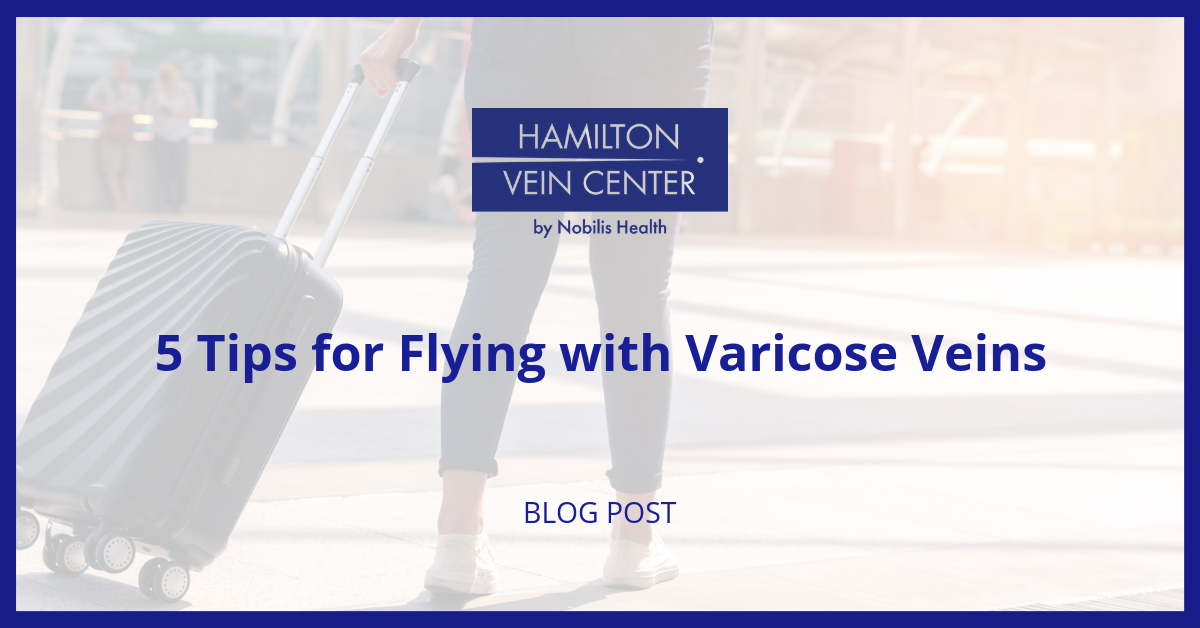5 Tips for Flying with Varicose Veins

Fear of a Long Flight
Air travel has its share of headaches: the long lines, the heavy security, and the cramped conditions if you’re seated in economy. But health conditions like varicose veins can make long flights even worse. The fact of the matter is that anything involving being seated for long periods of time is going to make symptoms worse; it increases the chance that blood will pool in lower limbs and raises the risk of dangerous blood clots.
That said, there are plenty things you can do to protect yourself and ensure your flight isn’t making your condition worse. Whether you’re a frequent flier or gearing up for a big trip, the tips we share here have helped countless varicose veins sufferers get from A to B with no problem. Let’s take a look:
Tip #1: Wait to Travel After Treatment
By far the greatest risk of flying with varicose veins is the risk of developing deep vein thrombosis (DVT): blood clotting in a deep vein. Clots can detach and get lodged in the pulmonary artery. This restricts respiration and can lead to death if untreated. These conditions can be closely related, and there’s some evidence of an increased risk of developing DVT following treatment for varicose veins.
This is why it’s advised that those who’ve had treatment for varicose veins wait for up to four weeks before planning air travel. You want to make sure varicose veins are managed and healed up before subjecting yourself to the strain of cramming yourself into an airplane seat. Get your doctor’s OK before take-off.
Tip #2: Stretch Break When Possible
As noted, the biggest issue with air travel for someone with varicose veins is the prolonged period of sitting entailed. This lack of activity can wreak havoc on veins in the lower legs and can lead to DVT. The solution? When the captain turns off the seatbelt sign, take a moment to get up, stretch, and walk around a bit. This increases positive blood circulation. A little activity every hour will go a long way. For ease of access, it might also be a good idea for someone with varicose veins to request an aisle seat.
Tip #3: Try Sitting Exercises
If getting up to walk around isn’t a practical option—perhaps there’s a great deal of turbulence or it’s inconvenient for you to get up—there are still some things you can do promote circulation. Try to move your legs a little while seated, and spend a little time tensing and relaxing calf muscles. Doctors may also advise doing some quick, easy ankle exercises: flex them as if you were pushing down pedals to drive 20 to 30 times every half hour. This will stimulate circulation to the lower limbs.
Tip #4: Don’t Forget Compression Stockings
Specialized compression stockings are the first line of treatment for varicose veins; by placing pressure on veins in the legs, they prevent blood from pooling and symptoms from forming. Even if you don’t regularly wear these, you may find them helpful if you’re travelling by plane. Typically, doctors will advise the best type for your case; sometimes something below the knees is sufficient, while in other cases you’d need longer ones.
Tip #5: Emphasize Hydration
Dehydration can worsen varicose vein cases and increase the chance of developing DVT. Because you’re in a pressurized cabin when you fly, air travel tends to dry you out. In the body, this causes blood to become more viscous, which impacts circulation. As such, it’s important for you to drink plenty of water when during plane trips. Unfortunately, if you enjoy alcohol, you’ll want to skip the adult beverages as these also cause dehydration.
Destination: Better Health
As with any aspect of your life, you can’t let health conditions get the best of you. If you have varicose veins or DVT and are planning on travelling, let your doctor know. They’ll be able to advise you on techniques or approaches that can make the trip much more bearable.
It’s also important to make sure you manage your health; if you suspect you may have a vascular issue, get medical help as soon as possible. There are more treatments than ever before for these conditions nowadays. With the right medical team at your side, varicose veins or related conditions will become a thing of the past.
If you suffer from varicose veins, the team at Hamilton Vein Center can help. The experts at these Texas-based outpatient clinics employ the latest in minimally-invasive approaches to ensure positive outcomes for their patients. Learn more about what they do by calling a Patient Care Manager at one of three locations: (281) 565-0033 for the Houston location, the Austin office at (512) 551-1403, or San Antonio at (210) 504-4304.